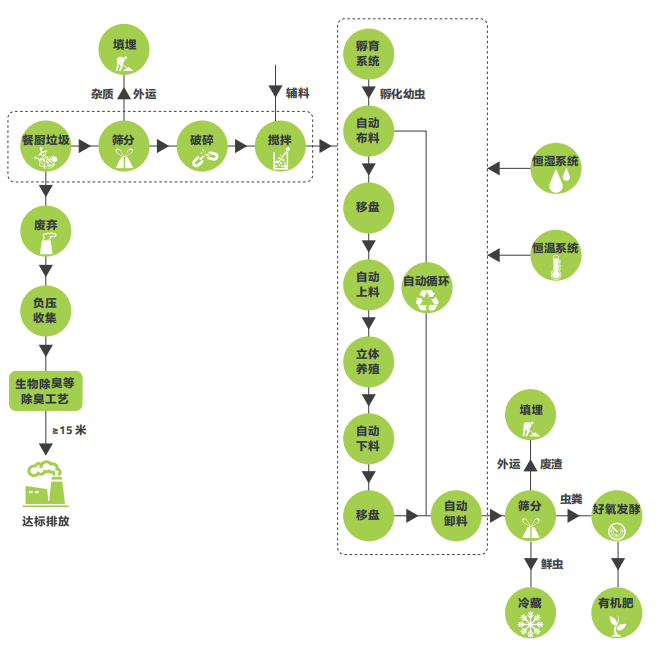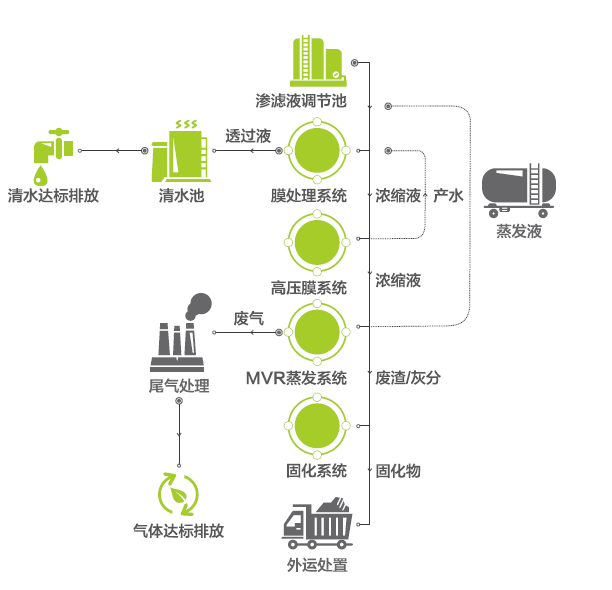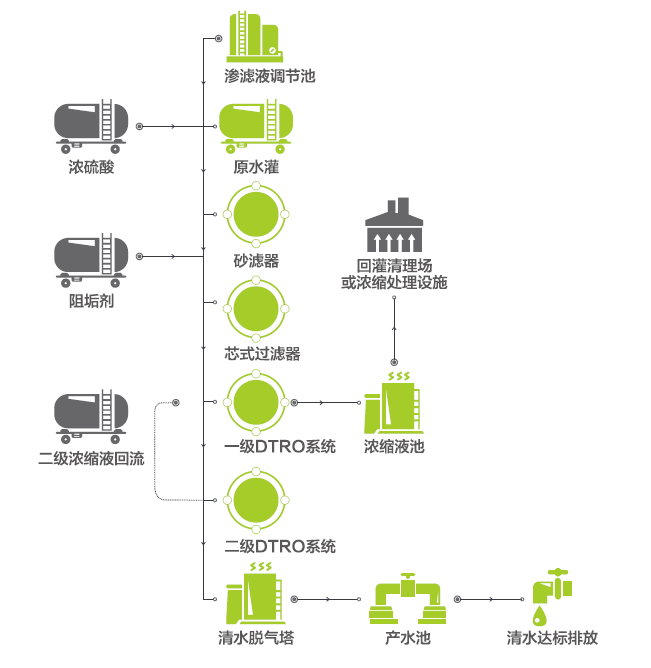Introduction Of Environmental equipment
Our environmental equipment manufacturing has three industrial lines, namely, village and town sewage line, landfill leachate line, and harmless treatment of kitchen waste.
Our two-stage DTRO membrane technique for landfill leachate treatment, technique for standard station-based treatment of town domestic sewage, and techniques for perishable waste-to-energy and control and treatment of secondary pollutants have been included in the Hunan Province Catalog of Practical Techniques for Environmental Protection. Our WZMS100/300/500 sewage treatment station has been included in the Hunan Province's Seventh Government Procurement Catalog of National Policy-Compliant Products. Our WJFSXD100.90 high concentration sewage treatment machine and complete sets of equipment for town domestic sewage treatment have received the support of Hunan Province's Identification and Special Funding for First (Set) of Significant Technical Equipment under Strong Manufacturing Province Initiative.
·Town Sewage Treatment Product Line
Leveraging Zoomlion-Enviro's strong capacities in product design and equipment manufacturing, the town sewage treatment product line has developed sewage treatment equipment for small towns, villages and individual users. The treatment capacity of a single piece of equipment is between 0.6t/d and 500t/d, enabling water environment treatment in different areas. Integrated, modular and standardized products including WZMS, WGZS, WGTDF and WGYLD suit different customer needs. They provide customers with flexible, reliable and comprehensive town sewage solutions with swift response, flexible configuration and intelligent IoT platform for level-by-level control over regional pollution sources.
·Leachate Treatment Product Line
The leachate treatment product line applies key technologies, such as membrane technology for leachate pre-treatment, concentrate reduction, concentrate evaporation, to products for treatment of leachate at landfill sites, waste-to-energy plants and waste transfer stations. Our whole-membrane system (UF/NF/TUF/RO) equipment includes membrane equipment for all technical processes. Our ultra-high pressure DTRO concentrate reduction equipment is capable of effective reduction of leachate concentrate. We also have MVR-based concentrate evaporation & crystallization process and equipment that can achieve near-zero discharge of landfill leachate. The leachate treatment product line has developed a stable and efficient process for leachate treatment: pre-treatment + biochemical-conventional membrane treatment / two-stage DTRO+ concentrate reduction + concentrate evaporation, supplemented by an intelligent IoT platform. It is a combination of technology for near-zero discharge treatment of landfill leachate and cloud management.
·Kitchen Waste Treatment Product Line:
Drawing on the organic waste treatment practice of the Italian company Ladurner, the kitchen waste treatment product line has developed full series of perishable waste pre-treatment equipment, including pre-treatment equipment for kitchen waste, food waste and other perishable mixed waste. We have also designed treatment processes and equipment for the classification of perishable waste in medium and large cities, including wet anaerobic and dry anaerobic processes and equipment. Besides, we have an efficient biological protein conversion process and full series of equipment suited for kitchen waste treatment in counties, and dispersed high-temperature aerobiotic process and on-site processing integrated equipment. These are cutting-edge in China.
·Technological Honors:
In recent years, our projects have won many awards, such as "China Machinery Industry Science and Technology Award", "Hunan Science and Technology Progress Award", "Huaxia Construction Science and Technology Award". Details are as follows: Project Name, Awards Applied, Awards Won, Resource Recovery Technology of Kitchen Waste & Intelligent Treatment Equipment, China Machinery Industry Science and Technology Award, Second Prize, Integrated Mobile Leachate Treatment Vehicle, Changsha Science and Technology Progress Award, Second Prize, Waste Classification System and Method ZL201210512351.1, The WIPO-CNIPA Award for Chinese Outstanding Patented Invention & Industrial Design, Outstanding Award, Resource Recovery Technology of Food Waste & Intelligent Treatment Equipment, China Machinery Industry Science and Technology Award, Second Prize
Zoomlion Enviro conducted field studies on sewage and experimental analyses of sewage quality in towns and villages, and found that, in villages and towns, 1) domestic sewage is discharged less but in a dispersed way; 2) water quality is subject to big changes; 3) sewage pipes are not close; 4) there are construction difficulties; 5) the traditional processes are not well adaptable; 6) there is a lack of technical management personnel. In view of these, Zoomlion-Enviro, by leveraging its strong capacities in product design and equipment manufacturing, has designed two series of integrated sewage treatment equipment, which are integrated, modular, high-performance, flexible, economical and reliable products for sewage treatment in towns and villages of different sizes. These products can address problems such as "difficult sewage collection", "high costs for sewage pipe construction", "large area", and "long construction period".
Main Treatment Process
Intelligent collection & transportation + pretreatment + insect treatment technology + organic product processing + odor treatment
"Intelligent collection & transportation + pretreatment + insect treatment technology + organic product processing + odor treatment" are adopted as core treatment processes to achieve a treatment capacity of ≥25t/d of waste in county-level cities, mainly kitchen waste but including bean dregs, distiller’s grains and animal feces. Therefore, with intelligent collection & transportation, modular design, and automatic control as the service concepts, kitchen waste treatment projects in county-level cities have a short period, require lower cost, and create higher added value.
Technical process of domestic sewage treatment plant
Technical process:
We provide flexible, economical, reliable and all-round sewage solutions for villages and towns according to sewage scales and needs.
Our integrated equipment adopts the A2O-MBR process, under which treatment is based on mainly biochemical methods, supplemented by physical methods. When sewage flows from the main sewage pipe, first, the large suspended solids and floating matters are stopped and removed by the grid; then, the sewage flows into the regulating tank for water quality and quantity regulation; after that, the sewage, after being filtered by the self-cleaning filter, enters the A2O-MBR treatment plant. The integrated equipment is composed of an anaerobic tank, anoxic tank, aerobic tank and MBR membrane, in addition to ultraviolet disinfection tube and electromagnetic flow meter. The equipment mainly removes organic materials, ammonia nitrogen, SS and phosphorus. The liquid in the MBR is discharged after being proved to comply with water discharge standards, and the remaining sludge is regularly discharged into the sludge storage tank. After being dehydrated by the mobile sludge dewatering truck, the solid mud is landfilled or placed in green spaces.
Process features:
This process is mature and reliable and being widely adopted in China. It enables a project to have a short period and be quickly launched and simply maintained. The project can be highly automatic and remotely controlled without special personnel on duty. This process has the following features: "Three Saving": Energy-saving, land-saving and cost-saving; "Two High": High-level equipment manufacturing, and high-level intelligence; "One Low": Low sludge creation rate; "One Good": Good discharged water quality.
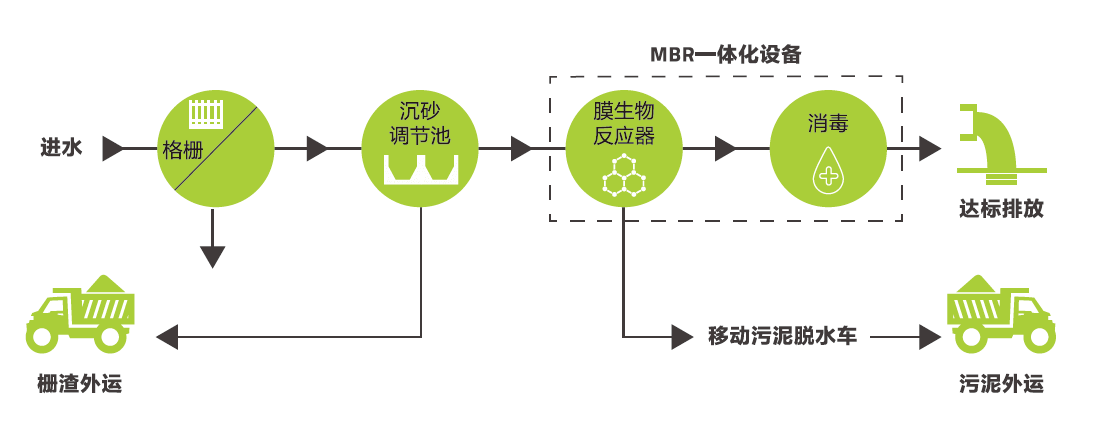
Membrane treatment + MVR evaporation process
Process description:
After the concentrated liquid from membrane treatment is reduced by high-pressure DTRO, it enters the MNR evaporation equipment; then, the produced liquid in MR is deeply treated or returned for front-end treatment by the membrane system so the liquid can meet the discharge standard. The exhaust gas and waste residue generated by evaporation are properly treated to avoid secondary pollution.
Process features:
High-pressure DTRO membrane separation process and MVR evaporation process are adopted, both of which are industry-leading, to effectively treat waste leachate and concentrate, thereby achieving the goal of nearly zero discharge of waste leachate during treatment.
Pretreatment + MBR + membrane evaporation process
Process description:
The pretreatment stage adopts UASB and other processes to improve the quality of water quality in MBR. MBR is composed of a biochemical system (two-stage AO) and an ultrafiltration system. Biochemical treatment aims to achieve denitrification and decarbonization of leachate in anoxic and aerobic environment, while the ultrafiltration treatment aims to separate leachate mud from water. The membrane treatment stage adopts DTRO, NF+RO and other processes to stop and remove the pollutants difficult to degrade by biochemical means. The pretreatment + MBR + membrane treatment process can stably guarantee that the discharged water can meet the discharge standard. The odor generated reacts in a biological deodorization apparatus or is burned in an incinerator. After the sludge generated is processed by the sludge dehydration system, the separated clear liquid is returned to the front end of the processing system, and the solid mud is transported to the landfill site for disposal, while the concentrate is recharged to the landfill site. If leachate is treated at a waste-to-energy plant, it undergoes an anaerobic pretreatment at the front end, and the concentrate at the back end can be disposed of in the waste-to-energy plant.
Process features:
This process applies to landfill leachate with good biochemical properties. The pretreatment + MBR + membrane treatment process is currently a commonly adopted biochemical treatment process for leachate. We can provide stable and reliable landfill leachate treatment processes according to hydrolytic acidification, coagulation air flotation, anaerobic treatment, MBR, TUF, NF+RO, DTRO, etc. for different water quality combinations. This process has such characteristics as stable operation, impact resistance, less inert by-products, high degree of automation, and stable water discharge.
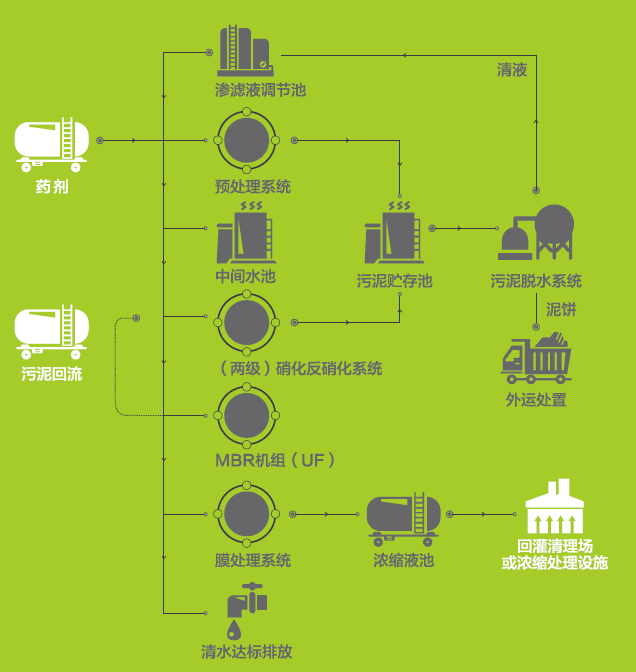
Pretreatment + two-stage DTRO treatment process
Process description:
The leachate in the regulating tank first enters the pretreatment system; after the suspended solids, colloids and other pollutants are removed, the leachate enters the two-stage DTRO membrane treatment system. After the liquid is processed by the DTRO system, it is directly discharged if it reaches the discharge standard. After the sludge from pretreatment is processed by the sludge dehydration system, the separated clear liquid is returned to the regulating tank, the solid mud is transported for treatment, and the concentrate is recharged to the landfill site.
Process features:
The pretreatment and membrane treatment stages are constructed by a combination of mature and reliable integrated equipment, which has such characteristics as short construction period, occupation of small area, simple maintenance, high degree of automation, and stable water discharge. This process is especially applicable to the treatment of leachate with poor biochemical properties at aging landfill sites. After an aging landfill site is filled and closed, it can be transferred and reused to maximize economic benefits.
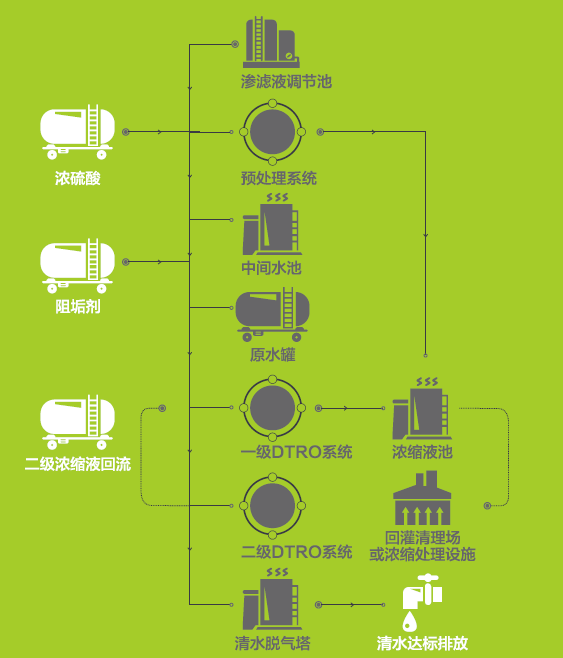
Two-stage DTRO treatment process
Process description:
The leachate is transported by a lift pump to the two-stage DTRO leachate treatment equipment for treatment. The produced liquid is directly discharged if it meets the discharge standard, and the concentrate is recharged to the landfill site.
Process features:
This process is mature and reliable, and has such characteristics as short construction period, occupation of small area, simple maintenance, high degree of automation, and stable water discharge. This process has been successfully applied to nearly 100 projects in China. It is especially applicable to the treatment of leachate with poor biochemical properties (containing a low level of SS) at aging landfill sites. After an aging landfill site is filled and closed, it can be transferred and reused to maximize economic benefits.
